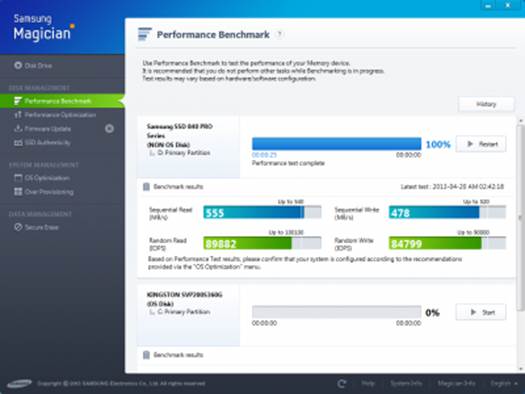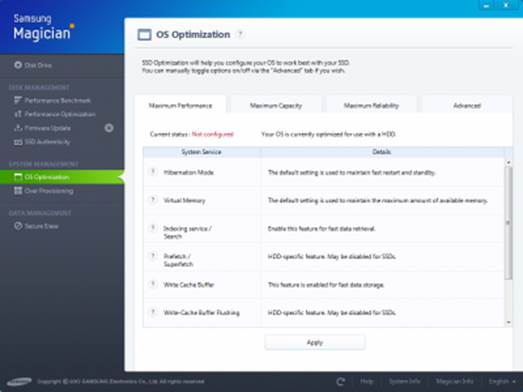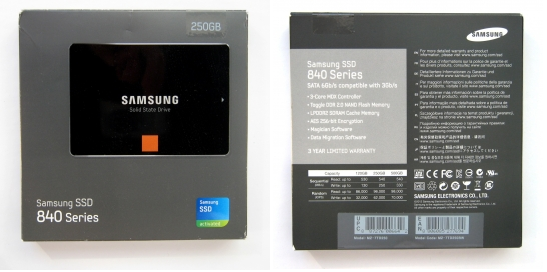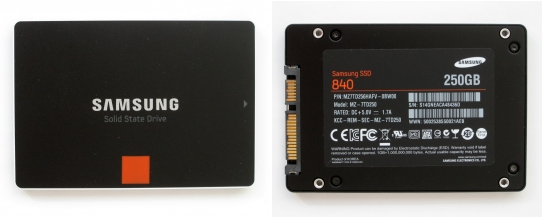Below is a summary of the Samsung 840 Pro
256GB specifications:
·
Controller: Samsung MDX;
·
Interface: SATA 6 Gbps;
·
Flash-memory: synchronous 21 nm Toggle Mode 2.0
MLC NAND;
·
Size: 256 GB / 238 GiB;
·
Cache-memory: 512 MB LPDDR2-1066 SDRAM;
·
Sequential read speed: up to 540 MB/s;
·
Sequential write speed: up to 520 MB/s;
·
Random read speed (4 KB blocks): 100,000 IOPS
·
Random write speed (4 KB blocks): 90,000 IOPS
The new controller's high performance
helped implement AES-256 encryption in the Samsung 840 Pro. You can activate it
and enter the encryption key via the mainboard BIOS.
Excellent software support is a great
advantage of the Samsung SSD. The Magician Samsung Utility is one of the best
tools to work with SSD drives. It is as good as Intel SSD Toolbox in its
functionality.

Samsung
Magician Utility
Besides standard functions, the Magician
utility offers a number of additional features including a synthetic
performance benchmark.

Samsung
Magician Utility
It can optimize OS settings for SSDs and
issue the TRIM command.

Samsung
Magician Utility
It can also create a reserve pool on the
SSD (up to 10% of its capacity) that is used for more efficient garbage
collection and helps improve the device's service life in high-load
environments.

Samsung
Magician Utility
It must be noted that even without any
tricks with Magician the formatted capacity of a Samsung 840 Pro 256GB is 238
gibibytes, so the manufacturer has allocated 7% of the total capacity of the
drive for the reserve pool. Considering that Samsung Pro 840 is positioned as a
professional solution, which is not surprising as it comes with a 5 year
warranty.
A closer look at the Samsung 840 250 GB
As manufacturing technologies get better, synchronous
MLC NAND flash memory has made inroads in relatively inexpensive SSDs. We want
to refer to the common types of flash memory whereas the Samsung 840 Pro uses
quite rare 21nm MLC NAND flash with Toggle Mode 2.0 interface, which isn't
expensive at all. The Pro version of new Samsung's SSDs may only be marketed in
the same price category with flagship SSDs from other brands. It is not a
product for the mass-market. That's why Samsung has also prepared a
modification with more affordable prices. The basic Samsung 840 features the
same hardware platform, but MLC NAND is replaced with cheaper TLC NAND (Triple
Level Cell), whose stores not two but three bits of data in each memory unit.
TLC NAND is not an innovation. It is widely
used in the USB flash drive. However, this is the first time we see it in an
SSD, so the Samsung 840 is considered as an experimental model. TLC NAND is
cheaper than the popular MLC NAND and also inferior to it across many
parameters. In particular, it has lower access speed and, even worse, shorter
service life. The following table illustrates this fact:

MLC
and TLC Comparison
TLC NAND flash can store not two but three
bits of data in each memory unit by increasing the number of electrical charge
levels on the transistor’s floating gate from 4 to 8. However, it becomes more
difficult to recognize the signals and programming such memory cell so it
requires higher voltage which leads to faster deterioration in the
semiconductor design. The higher bit density results in smaller physical size.
MLC NAND needs 1.5 times more transistors to store the same amount of data as
TLC NAND flash. And because the transistors are actually the same, TLC NAND
flash is considered 1.5 times cheaper than the MLC NAND flash.
Using TLC memory in inexpensive SSDs is an
attractive opportunities but no one has ever tried to do it at all. The
manufacturers and users have apprehensions about its low service life which is
declared to be 1000 program/erase cycles. However, a simple calculation can
show that, assuming a realistic write amplification coefficient of 3x, saving
20 GB of data to a TLC-based 256GB SSD daily will only make it down in 11
years. A 128GB SSD will only last half of that time, but it is still more than
enough for a consumer-class SSD.
So the Samsung 840 is considered to be a
compromise. It is theoretically not as long-lasting as SSDs with MLC NAND flash
but, on the other hand, it represents an inexpensive version of one of the
fastest SSD platforms available. Samsung is quite confident about its
reliability, shipping this inexpensive SSD with a standard 3-year warranty.
The Samsung 840 is not much different from
its Pro version cousin in accessories or appearance. The manufacturer obviously
doesn’t want to emphasize its entry-level positioning or inferiority, so it
looks as noble as the Samsung 840 Pro. Its box is just a little different in
design, using gray as the dominant color. The pictures on the front of the
packaging show that this SSD looks a little different if you look in the same direction.

Like
the Pro version, the basic 840 model comes with some documentation and a CD
with electronic manual and software.
Like the Pro version, the basic 840 model
comes with some documentation and a CD with electronic manual and software.
There is no adapter to mount it into 3.5-inch system case bays. There was also
no frame or something to increase its thickness from 7 to 9.5 mm.
The SSD looks identical to its senior
cousin, so you can only distinguish the basic 840 and the 840 Pro by the
information from the sticker on the bottom surface of the unified case.

Bottom
surface of the unified case
Considering that the Samsung 840 uses the
same hardware platform as the flagship version, there's a familiar PCB inside
but some of the chips populating it are different.

Product's
circuit board
The memory chips are labeled
K9CFGY8U5A-CCK0 instead of K9HFGY8U5A-CCK0, so it is TLC NAND, although the
designed chips are the same. Each chip has four 21nm fixed transistors with
Toggle Mode 2.0 interface. There are eight chips in total, each with a capacity
of 32 GB and the Samsung 840 uses 4-way interleaving on each controller.
Otherwise, the Samsung 840 have similar
components as its senior cousin including a 512MB LPDDR2-1066 SDRAM chip for
cache (it is labeled K4P4G324EB-FGC2). The controller is the same. Thus, the
Samsung 840 retains important advantages of the Pro version, its
high-performance triple-core processor. The lower specified read and write
speeds are only due to the higher-latency flash memory.
Below is a summary of the Samsung 840 Pro
256GB specifications:
·
Controller: Samsung MDX;
·
Interface: SATA 6 Gbps;
·
Flash-memory: synchronous 21 nm Toggle Mode 2.0
MLC NAND;
·
Size: 250 GB / 233 GiB;
·
Cache-memory: 530 MB LPDDR2-1066 SDRAM;
·
Sequential read speed: up to 240 MB/s;
·
Sequential write speed: up to 520 MB/s;
·
Random read speed (4 KB blocks): 95,000 IOPS
·
Random write speed (4 KB blocks): 44,000 IOPS
Considering the official specs, the slower
TLC memory affects write speed in the first place, the Samsung 840 is just half
as fast as the Samsung 840 Pro at writing. The read speed is not much
different. Another thing to note is that the storage capacity of the Samsung
840 is 6GB smaller because the reserve pool is larger at 9% of the total
capacity. This may explain the TLC memory's shorter service life.
Although the Samsung 840 is a budget
product, its manufacturer had not deliberately strip it of extra features. As
the Pro version, it supports AES encryption with 256-bit key and is compatible
with the exclusive Magician utility.
In other words, the Samsung 840 offers the
same functionality as the Pro version. The difference is in performance and, in
theory, in service time, which is reflected in the shorter warranty period.